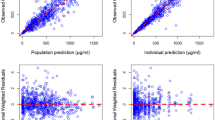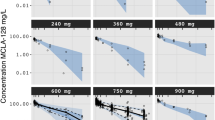Abstract
Purpose
MEHD7945A is a novel dual-action monoclonal antibody in which each of the two antigen-binding fragments is capable of binding to EGFR and HER3 with high affinity. It is being evaluated as a potential therapy for human cancer. The purpose of these studies was to characterize the pharmacokinetics (PK) of MEHD7945A in mouse and monkey and predict its human PK and efficacious dose.
Methods
PK of MEHD7945A was determined in SCID beige mice and cynomolgus monkeys after administration of single intravenous doses. Human PK profiles were projected from monkey PK profiles using a species-invariant time method, and human population PK parameters were estimated using a nonlinear, two-compartment model comprising specific (target-mediated) and nonspecific clearance pathways. The antitumor efficacy in mice bearing human tumor xenografts was used in conjunction with human PK projections to estimate human efficacious doses.
Results
The total clearance of MEHD7945A decreased with increase in dose in both mouse and monkey. The nonspecific clearance in monkey was estimated to be 14 mL/day/kg. The predicted nonspecific clearance range in humans was 6–10 mL/day/kg. Doses of 8–12 mg/kg administered every 2 weeks in humans were predicted to achieve exposure of 300 day μg/mL per week to match the efficacious exposure observed in xenograft models.
Conclusions
The PK of MEHD7945A was nonlinear in mouse and monkey in the dose range tested. The nonspecific clearance in monkey was approximately twofold higher than typical humanized IgG1 antibodies. The projected human efficacious dose and dose regimen appear to be achievable in patients.





Similar content being viewed by others
References
Arteaga C (2003) Targeting HER1/EGFR: a molecular approach to cancer therapy. Semin Oncol 30(3 Suppl 7):3–14
Hynes NE, MacDonald G (2009) ErbB receptors and signaling pathways in cancer. Curr Opin Cell Biol 21:177–184
Ciardiello F, Tortora G (2008) EGFR antagonists in cancer treatment. N Engl J Med 358:1160–1174
Soltoff SP, Carraway KL, Prigent SA, Gullick WG, Cantley LC (1994) ErbB3 is involved in activation of phosphatidylinositol 3-kinase by epidermal growth factor. Mol Cellular Biol 14:3550–3558
Schoeberl B, Pace EA, Fitzgerald JB, Harms BD, Xu L, Nie L, Linggi B et al (2009) Therapeutically targeting ErbB3: a key node in ligand-induced activation of the ErbB receptor-PI3K axis. Sci signal 2:ra31
Hsieh AC, Moasser MM (2007) Targeting HER proteins in cancer therapy and the role of the non-target HER3. Br J Cancer 97:453–457
Sergina NV, Moasser MM (2007) The HER family and cancer: emerging molecular mechanisms and therapeutic targets. Trends Mol Med 13:527–534
Bostrom J, Yu SF, Kan D et al (2009) Variants of the antibody herceptin that interact with HER2 and VEGF at the antigen-binding site. Science 323:1610–1614
Schaefer G, Haber L, Crocker LM, Shia S, Shao L et al (2011) A two-in-one antibody against HER3 and EGFR has superior inhibitory activity compared to monospecific antibodies. Cancer Cell 20(4):472–486
Mould DR, Green B (2010) Pharmacokinetics and pharmacodynamics of monoclonal antibodies. Biodrugs 24(1):23–39
Dedrick RL (1973) Animal scale-up. J Pharmacokinet Biopharm 1:435–461
Deng R, Iyer S, Theil FP, Mortensen D, Fielder P, Prabhu S (2011) Projecting human pharmacokinetics of therapeutic antibodies from nonclinical data. mAbs 3(1):61–66
Mahmood I (2004) Interspecies scaling of protein drugs: prediction of clearance from animals to humans. J Pharm Sci 93:177–185
Dirks NL, Meibohm B (2010) Population pharmacokinetics of therapeutic monoclonal antibodies. Clin Pharmacokinet 49:633–659
Schoeberl B, Faber AC, Li D, Liang MC et al (2010) An ErbB3 antibody, MM-121, is active in cancers with ligand-dependent activation. Cancer Res 70:2485–2494
Acknowledgments
We thank the In Vivo Studies Group at Genentech for conducting the mouse PK study and Celso Wang for coordinating the monkey PK study with Covance Laboratories.
Author information
Authors and Affiliations
Corresponding author
Rights and permissions
About this article
Cite this article
Kamath, A.V., Lu, D., Gupta, P. et al. Preclinical pharmacokinetics of MEHD7945A, a novel EGFR/HER3 dual-action antibody, and prediction of its human pharmacokinetics and efficacious clinical dose. Cancer Chemother Pharmacol 69, 1063–1069 (2012). https://doi.org/10.1007/s00280-011-1806-6
Received:
Accepted:
Published:
Issue Date:
DOI: https://doi.org/10.1007/s00280-011-1806-6




